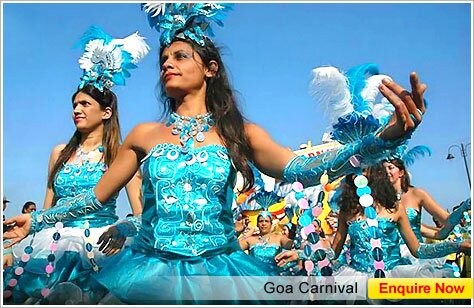Cabo Raj Niwas Or The Cabo Palace in Goa
Cabo Palace in Goa |
| Built in 1540 AD opposite Fort Aguada on the south headland of the river Mandovi, the Cabo (the Portuguese word for cape) Palace fortress housed the Franciscan monastery, which later (1594 AD) became the official residence of the Governor of Goa. Holding the most panoramic view one can witness in Goa with the Indian Ocean towards the west, the Bay of the river Mandovi and Fort Aguada on the north and the busy port of Mormugao. Remaining unhabitated and isolated for centuries, it is believed some human habitation must have been present over here but because of its enclosure in a dense wilderness, no signs of earlier settlements found. The beauty, solitude and uniqueness and well-planned features are some of the main attrACTIONs of the Cabo. A small Chapel was constructed at the very end of the mansion dedicated to Our virgin lady of The cape (Nossa Senhora do Cabo). It also served as a landmark for the seafarers. Click here for Forts Tour in Goa The Construction Of The Fortress The exact date about the first construction of the fort is not known but in a recently discovered note dated 30th June 1541, there was a proposal to locate a Franciscan priest at the chapel, which already existed. In 1540, the eighth Governor, D. Estevao de Gama, proposed the idea of constructing some fortifications at the mansion site to guard the entrance to both the Mandovi and Zuari rivers. The Cabo was converted into one of the best equipped and important fortresses over the years. Making Of The Monastery In the meantime, the chapel caught the attention of the Viceroy D. Matias d Albuquerque (1591-97) who became one of its committed devotees. He was a protector of the reformed Franciscan friars known as "Recollects". The Viceroy decided to rebuild the chapel and also constructed a monastery beside it. He paid all the expenses involved in its construction. He even imposed a condition that the Franciscans would look after the chapel and if by any chance they have to leave the place, it would be handed over to the archdiocese for proper maintenance. The foundation of the monastery was laid started of on 5th February 1594 by Bishop de Santa Maria and was completed within the period of six months only, exactly on 14th July 1594. The whole construction was done with laterite stones, which is available at the site. The Cabo is on a rock of laterite and it was extracted from the rocky peninsula on the spot. The pits formed from the extrACTIONs of stone were then covered to form cisterns to which rainwater was carried via the sloping roofs of the edifices. This provided excellent storage tanks for water. This system was also carried out in various other forts present in Goa. The Present Raj Niwas The Cabo Palace is now known as the Raj Bahavan, the official name given to the residence of the Governors of the States In India. It is also counted among the finest residences of Indian Governors and is indeed the oldest as no other residence of a Governor of a State in India had its origin to over four hundred years in the past. The official reception area consists area consists of a large hall called the Darbar Hall, used at the time of receptions and swearing in ceremonies and other official occasions. The Dining room has a seating capacity of over 30 persons. The living quarters of the Governor and his family are on the same floor. A glossy verandah runs along the entire portion overlooking the Mandovi Bay and the Arabian Sea giving one a feeling of being on a ship's deck. There are three suites and seven double rooms for guests. The offices of the Governor, his secretariat and staff are located on the ground floor in a separate annex. Collectibles Within The Palace The Raj Bhavan has a fine collection o Bohemian chandeliers, Chinese porcelain, silver and furniture. The most remarkable are the beautiful pieces of antique Chinese porcelain presumably manufactured in Canton. |
SignificanceResidence Of The Governor Of The State. |
General Information |
|
Location
Opposite Fort Aguada.
|
Prime AttrACTIONs of Panjim |
|
At the place where two of Goa's famous rivers meet the Arabian Sea is the secluded bay of Dona Paula with a fine view of the Marmagao Harbour. more.. |
|
Built in 1602, the only ruin of the Church of St. Augustine on the Holy Hill at Old Goa near the Nunnery, is a lofty 46-metre high tower defying the torrential rains. more.. |
|
About 2-km on the main road towards Ponda, a Kuchcha road branches off to a place where a cross is fixed. The road leads to a hill on which, commanding a picturesque view, is the Chapel of Our Lady of the Mount more.. |
|
In the Holy Hill, on the way to the Church of Our Lady of the Rosary, is a huge three-storeyed building of laterite which was originally lime-plastered but is now plastered with cement. more.. |
|
Not far to the west of the Basilica of the Bom Jesus is the Holy Hill at the extremity of which is the Church of Our Lady of the Rosary. more.. |
|
To the west of the Se Cathedral is the former palace of the Archbishop that connects the Se Cathedral to the Convent and Church of St. Francis of Assisi. more.. |
|
It is built of laterite plastered with lime mortar, with tiled roof supported by wooden rafters is a plain chapel with only one altar. more.. |
|
Aguada Fort, which crowns the rocky flattened top of the headland, is the best-preserved Portuguese bastion in Goa. Built in 1612 to protect the northern shores of the Mandovi estuary from Dutch and Maratha raiders more.. |
|
The museum has been functioning since 1964 in the abandoned convent of St. Francis of Assisi and is maintained by the Archaeological Survey of India (ASI). The collection consists of Brahmanical sculptures hero-stones and sati stones of the early and late medieval periods, portraits, coins and currency, revenue and court fee stamps, wooden and bronze sculptures and armoury of the Portuguese period. more.. |
|
The Museum of Goa is housed at a new Building at the Patto Plaze near the Ourem creek, Panaji. The most noteworthy feature of Panjim's State Archeological Museum is its imposing size, which stands in glaringly inverse proportion to the scale of the collection inside. more.. |
|
Up in the lush foothills of the Western Ghats, Bondla is good place to see Sambhar and Wild Boar. It is smallest of the Goan Wildlife Sanctuaries. Its area is 8-sq-kms but easiest one to reach. more.. |
|
A mere 45 minute bus ride up the coast from the capital, Calangute is Goa's busiest and most commercialized resort more.. |
|
On the way to Dona Paula, 1-km ahead of the confluence of the Arabian Sea and Mandvi River, under the palm shade, is "Gasper Dias" or Miramar Beach and is just 3-km away from the capital city of Panjim. more.. |
|
The Portuguese Viceroy Redondo commissioned the Se, or St. Catherine's' Cathedral, southwest of St. Cajetan's, to be "a grandiose church worthy of the wealth, power and fame of the Portuguese who dominated the seas from the Atlantic to the Pacific". more.. |
|
3-km away from Banastari Bridge on Panaji-Ponda Road is situated the noteworthy temple dedicated to Devaki Krishna at Marcel. The deity is said to have been brought from Chorao in Tiswadi to Mayem in Bicholim and then shifted to its present place during the days of religious persecution by the alien rulers. more.. |
|
Situated in West Goa, the Mahadeva Temple in Tambdi Surla is the state's only prominent reminder of the pre-Portuguese temple architecture. Maintained by the ASI (Archeological Survey of India), this 12th century temple boasts of some fine relief's on the 'Shikhara' (spire) depicting a plethora of Gods and Goddesses. more.. |
|
The temple tour can be resumed by offering prostrations unto Goddess Mahalakshmi, the presiding deity of Panaji, the capital of Goa. The main temple has been reconstructed recently. The main festivals at this temple are Navaratri and Chaitra Purnima. more.. |
|
As one tries to return to Panaji from Harvalem, one can visit the famous temple of Sri Saptakoteshwar Naroa, Bicholim. Sri Saptakoteshwara was the patron deity of the Kadambas who had built a beautiful temple dedicated to this deity at the Diwar Island. more.. |
|
From Kansarpal one can proceed to Sanquelim, the hometown of the Ranes of Satari who played key role in Goa's freedom struggle. The ancestors of the present Rane family, who are believed to have migrated to Goa from Udaipur about 600 years ago, built the famous Sri Vithal temple situated on the bank of Valvanta River. more.. |
|
Further to the west of the Church of St. Francis of Assisi is the chapel of St. Catherine. Built of laterite blocks it has a tower on either side of the façade. The chapel in the interior, having only one altar is plain more.. |
|
Opposite the Se Cathedral, beyond the road is the large and beautiful church of St. Cajetan built of laterite blocks, which were lime plastered. more.. |
|
Nothing remains of the Church of the Carmelites excepting the façade and a raised pavement, which served as an altar. Its location is to the southeast of the Church of St. Cajetan more.. |
|
Situated to the east of the tower of St. Augustine it is a plain looking building constructed in the beginning of the 18th century. The convent was abandoned in 1835. The Society of the Misericordia occupied it for some time. more.. |
|
On the southern outskirts of Old Goa is a hill on which stand this convent and church. more.. |
|
Immediately to the south of the main road is the Professed House, a two-storeyed laterite building covered with lime plaster. Despite the opposition, which the Jesuits faced, the building was completed in 1585. more.. |
|
To the west of the tower of St. Augustine is the Royal Chapel dedicated to St. Anthony, the national saint of Portugal and held in great veneration by the Portuguese. It was built in the beginning of the 17th century. more.. |
|
Condolim Beach
Four or five years ago, Candolim, at the far southern end of Calangute beach, was a surprisingly sedate resort, appealing to an odd mixture of middle-class Bombayites, and Burgundy-clad Sannyasins taking a break from the Rajneesh Ashram at Pune. |
Hotels & Resorts in Goa |
|||
more goa hotels...
|
more goa resorts...
|
||
|
|
Suggested Tour Packages
Tour Code: GTT - 001
Duration: 8 Days / 7 Nights Destinations Covered: Mumbai - Goa - Cochin - Mumbai |
 |
|
|
|
||
Tour Code: GTT - 005
Duration: 11 Days / 10 Nights Destinations Covered: Goa - Panjim - Cochin - Munnar - Periyar - Cochin |
 |
|
|
|
||
Tour Code: GTT - 006
Duration: 5 Days / 4 Nights Destinations Covered: Goa - Panjim - Savoi - Panaji |
 |
|
|
|
||
| » Other Goa Holiday Packages | ||
North India Tour with Goa
Rajasthan Heritage with Goa
Goa Travel Package
Goa Beach Holidays
Goa Beach Vacation
Romantic Goa Honeymoon
Goa Tour Package
Travelling in Goa
Goa Vacation
Goa Trips
Goa Vacation Package
Goa Beach Tour
Rajasthan Heritage with Goa
Goa Travel Package
Goa Beach Holidays
Goa Beach Vacation
Romantic Goa Honeymoon
Goa Tour Package
Travelling in Goa
Goa Vacation
Goa Trips
Goa Vacation Package
Goa Beach Tour
... more Goa Tour Package
Goa Luxury Hotels
Hotel Taj Exotica
The Leela Palace Hotel
Bambolim Beach Resort
Majorda Beach Resort
Cidade De Goa
Hotel Taj Exotica
The Leela Palace Hotel
Bambolim Beach Resort
Majorda Beach Resort
Cidade De Goa
...more Luxury Hotels
...more Deluxe Hotels
Goa Budget Hotels
Alor Holiday Resort
Anjuna Beach Resort
Dona Paula Beach Resort
Resorte De Goa
Don Jóao Resort
Goa Guest Houses
Alor Holiday Resort
Anjuna Beach Resort
Dona Paula Beach Resort
Resorte De Goa
Don Jóao Resort
Goa Guest Houses
...more Budget Hotels
...more Goa Heritage Hotels
...more Resorts in Goa
Goa Boutique Hotels
Banayan Tree Courtyard
Devaaya Ayurvedic Spa
Montego Bay Beach Village
Vainguinim Valley Resort
Banayan Tree Courtyard
Devaaya Ayurvedic Spa
Montego Bay Beach Village
Vainguinim Valley Resort
...more Goa Boutique Hotels
...more Goa Hotels
...more South Goa Hotels
|
Plan a Tour
|
Book a Hotel
|
...more Goa Beaches
...more Goa Churches
Others
...more Travel Guide
...more Things to Do
...more Travel Guide










